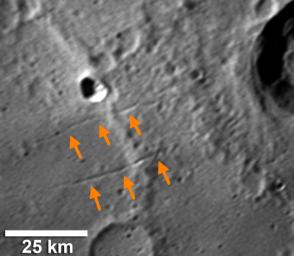
|
Searching for Evidence of Extension on Mercury
- Click the image above for a larger view
- Full-Res JPEG (1205 x 1050) (87.1 kB)
- Full-Res TIFF (1205 x 1050) (3.8 MB)
Caption:
Mercury's surface shows many lobate scarps , which are caused by contraction (horizontal shortening) of the crust. In contrast, surface features indicative of extension (horizontal stretching) are rare on Mercury and have been previously identified only within the interiors of four large impacts basins: Caloris basin , Raditladi basin , Rembrandt basin , and a newly imaged basin from Mercury flyby 3. However, MESSENGER's high-resolution images are enabling an examination of Mercury's surface in unprecedented detail, and the above image shows the first evidence of extension outside of the floor of an impact basin. Visible near the center of the image are two narrow, northeast-southwest-trending troughs (orange arrows), interpreted to be landforms created by faulting in response to crustal extension.
Date Acquired:
September 29, 2009
Instrument:
Narrow Angle Camera (NAC) of the Mercury Dual Imaging System (MDIS)
Scale:
25 kilometer (16 mile) scale bar given on image
Background Info:
These images are from MESSENGER, a NASA Discovery mission to conduct the first orbital study of the innermost planet, Mercury. For information regarding the use of images, see the MESSENGER image use policy .
Cataloging Keywords:
| Name | Value | Additional Values |
|---|---|---|
| Target | Mercury | |
| System | ||
| Target Type | Planet | |
| Mission | MESSENGER | |
| Instrument Host | MESSENGER | |
| Host Type | Orbiter | |
| Instrument | Mercury Dual Imaging System (MDIS) | |
| Detector | Narrow Angle Camera (NAC) | |
| Extra Keywords | Color, Impact | |
| Acquisition Date | ||
| Release Date | 2010-03-02 | |
| Date in Caption | 2009-09-29 | |
| Image Credit | NASA/Johns Hopkins University Applied Physics Laboratory/Carnegie Institution of Washington | |
| Source | photojournal.jpl.nasa.gov/catalog/PIA12852 | |
| Identifier | PIA12852 | |
